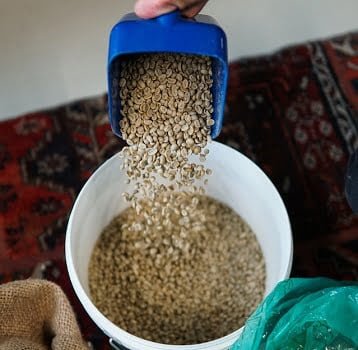Coffee blends are where the magic happens. Imagine: Kenyan brightness waltzing with Sumatran earthiness, Ethiopian fruitiness tangoing with Guatemalan chocolate. Sounds good, right?
Key Takeaways
- Coffee blends combine beans from different regions to create balanced flavor profiles.
- Blending provides reliable and consistent flavors throughout the year.
- There are blends for every palate; from robust espresso blends to gentle pour-over types.
- Coffee blends are often made with cheaper and low-quality beans to minimize the cost.
- Espresso blends are typically roasted darker with some robusta for thick, intense shots.
- Mocha Java is the most popular blend prepared with chocolaty Yemeni Beans and intense Indonesian beans.
- You can make DIY blends at home by combining preferred beans in different ratios.

As a barista with over a decade of experience, I’ve found most coffee drinkers don’t actually know what a blended coffee is. In this article, I’ll explain the benefits of coffee blends, their distinctive flavor profiles, and tips for choosing the right blend for your tastes.
What is a Coffee blend?
A coffee blend is an expertly crafted combination of coffee beans from different regions, specially curated for a unique and consistent flavor profile. The goal of blending beans is to create a complex and balanced coffee profile that showcases the best qualities of each component.
For example, a bright floral Ethiopian coffee is blended with intense Sumatran coffee to yield a coffee that has the depth of Sumatra with the fruitiness of Ethiopian.
While single origin coffee focuses on terroir, blends use quality coffees from different regions for a balanced and consistent taste year around.
I’ve found that both blends and single origins have merits – blends provide approachable, comforting flavors, while single origins offer exciting opportunities to experience new coffees.
How is Coffee blended?
There are two main methods for blending coffee – either blending the unroasted green beans or blending after the beans have been roasted.
1- Pre-roasting blending: Blending green beans allows the flavors to develop together during the roast, creating a smooth, integrated profile. That’s the most common practice for making commercial coffee blends.

2- Post-roasting blending: This involves combining already roasted beans. While uncommon, blending after roasting allows for fine-tuning based on each roast’s distinct flavor profile. However, it can be challenging to achieve consistent results due to varying roast levels.
This is the method used by home Baristas.
I sometimes blend medium Colombian, dark Indonesian, and bright Ethiopians to create a complex blend with a nice rich body, some fruitiness, and hints of spice.

5 benefits of coffee blends
1. Reliable and consistent flavors
Roasters craft coffee blends to ensure a steady and dependable flavor profile throughout the year.
For example, skillful blending allows roasters to perfect a proprietary flavor profile. This ensures customers can enjoy the same comforting balance of flavors in every cup, morning after morning.
2. It allows roasters to be creative
Blending allows roasters to experiment and craft unique flavor experiences instead of just representing what the farmers created.
For example, a roaster could produce a lively blend mixing fruity Ethiopian Arabica beans with caramelly Brazilian beans and intense Sumatran beans. Skillfully mixing these beans will craft a drink with a rich, syrupy body balanced by bright fruit notes.
Roasters get to experiment, tweaking ratios until they strike that perfect chord, creating something entirely new and delightful for coffee enthusiasts to savor.
From an artistic standpoint, creating a “signature blend” establishes a roaster’s position as a brand — meaning consumers can know what to expect when they buy a specific product.
Tastingtable
Also Read: Where is the best Coffee grown
3. You can easily brew consistent coffee
One advantage of coffee blends is their forgiving brewing profile that enables making a consistent cup time after time.
In contrast, finicky single-origin coffees often require dialing in just the right water temperature or brew time to properly unlock their intricacies.
4. There’s a blend for every coffee lover
Another advantage to coffee blending is there’s something for everyone’s taste buds. Coffee blenders can carefully calibrate ratios of beans to cater to diverse palates.
For instance, Robust blends brim with bite and velvety body for espresso fans, while gentle blends might capture flavor nuances for pour-over purists.
In between, choices abound – perhaps a harmonious blend mixing the spice of Sumatra, berry notes of Ethiopian, and chocolate finish of Guatemalan for those seeking balanced flavors.
5. It allows to make use of low-quality beans
Coffee blends offer the advantage of utilizing lower-quality beans effectively that are too bitter to drink on their own.
While single-origin coffee celebrates distinct flavors, not all origins produce beans suitable for standalone enjoyment.
For instance, Some robusta beans or lower-graded arabicas have overly earthy, woody notes. Rather than waste these crops, skillful blending balances out their unfavorable qualities and amplifies their favorable qualities.
Specialty blends can help roasters develop a specific flavour profile, while optimising costs, as well as the freshness and quality of the product
Perfectdailygrind
A Coffee blend is not always good
While blending offers many benefits here are some reasons why coffee blends are not always ideal:
First, most blends just create muddled flavors lacking the intriguing clarity and distinction celebrated in single-origin coffees.
When you combine too many beans competing for attention, rather than balancing harmoniously, none of the individual notes shine.
And the blends are often roasted very deeply to hide and mask those inconsistencies.
Second, Coffee blends are often cheaper as commercial coffee blenders use lower-grade filler beans simply to cut costs.
Coffee blends vs Single origin coffee
Single-origin coffees are like discovering unique flavors from specific places, such as sipping fruity notes from Ethiopia or rich chocolaty tones from Colombia.
It’s a bit like exploring different countries through your cup, each sip revealing a new story.
On the other hand, coffee blends are like a delicious mixtape, combining beans from various spots to create a smooth and consistent flavor profile
Blends aim to achieve a reliable, consistent profile by combining beans of complementary flavors. Meanwhile, single origins showcase more originality – that distinct sweet berry note or rich chocolate vibe from a specialty coffee bean.
Personally, I always prefer exotic single origins like Hawaiian Kona, Etipoian Yigracheffe, and Jamaican Blue Mountain.
Coffee blends vs Espresso blends | Is there any difference?
A common misperception is that there are inherent differences between “coffee beans” and “espresso beans.”
Any beans can work for espresso or drip coffee but will highlight certain characteristics depending on preparation.
Espresso blends are typically roasted darker and contain some amount of robusta beans blended with Arabica beans. The robusta provides an intense, syrupy shot with a thicker layer of crema froth on top that many espresso drinkers love.
But robusta can taste harsh in other brew styles. So while the beans themselves don’t differ, roasters use careful blending recipes to maximize flavors for espresso versus regular coffee.
Check out my favorite Espresso Beans
Mocha Java: The most famous coffee blend
Mocha Java brings together coffees from Yemen and Indonesia. This classic blend dates back over 500 years when trade ships traveling between the ports of Mocha, Yemen, and Java would mix beans from the two regions.
Though the original ingredients are rarely used today, most Mocha Java blends combine deep, chocolatey African coffees with smooth, thick-bodied Indonesians for a rich, complex profile.
When properly roasted and extracted, the blend showcases earthy spices, dark cocoa, dried fruit sweetness, and a smooth mouthfeel.
How to Blend Coffee at Home
Making your own custom coffee blends at home is super easy!
- First, you’ll need to pick 2-3 types of roasted whole bean coffees that you enjoy and that have flavor profiles that you think will complement each other well.
For example, you could do a medium roast Colombian, a light roast Ethiopian, and a dark roast Sumatran for a blend that is balanced, complex, and has some nice fruit and spice notes.
- Next, measure out the beans using a kitchen scale. A good starting point is a 40/30/30 ratio – so if you are making a 10 oz blend, use 4oz of the Colombian, 3 oz of the Ethiopian, and 3 oz of the Sumatran.
- Grind the beans together on a medium coarse setting so they are ready for drip coffee brewing.
- Now just brew the blended coffee grounds like you normally would, taste the drink, and take the notes.
Experiment with different bean ratios until you settle on your perfect flavor combo. With some trial and error, you’ll be able to create your own signature blends to enjoy at home!

Discover Exciting articles related to Coffee beans:
- What are Fermented Coffee Beans
- What is Geisha Coffee
- Where do Coffee beans come from
- What is Honey Processed Coffee
- Washed vs Natural Coffee Beans
Final thoughts
And there you have it – a complete guide to coffee blends!
From understanding the different types of beans that go into a blend to learning how roasters craft unique flavor profiles, I hope this article sheds some light on this complex and fascinating topic.
Now I’d love to hear from all you coffee lovers out there! Have a favorite blend you’d like to shout out? Any blending tips or fun facts to add? Let me know in the comments below.



